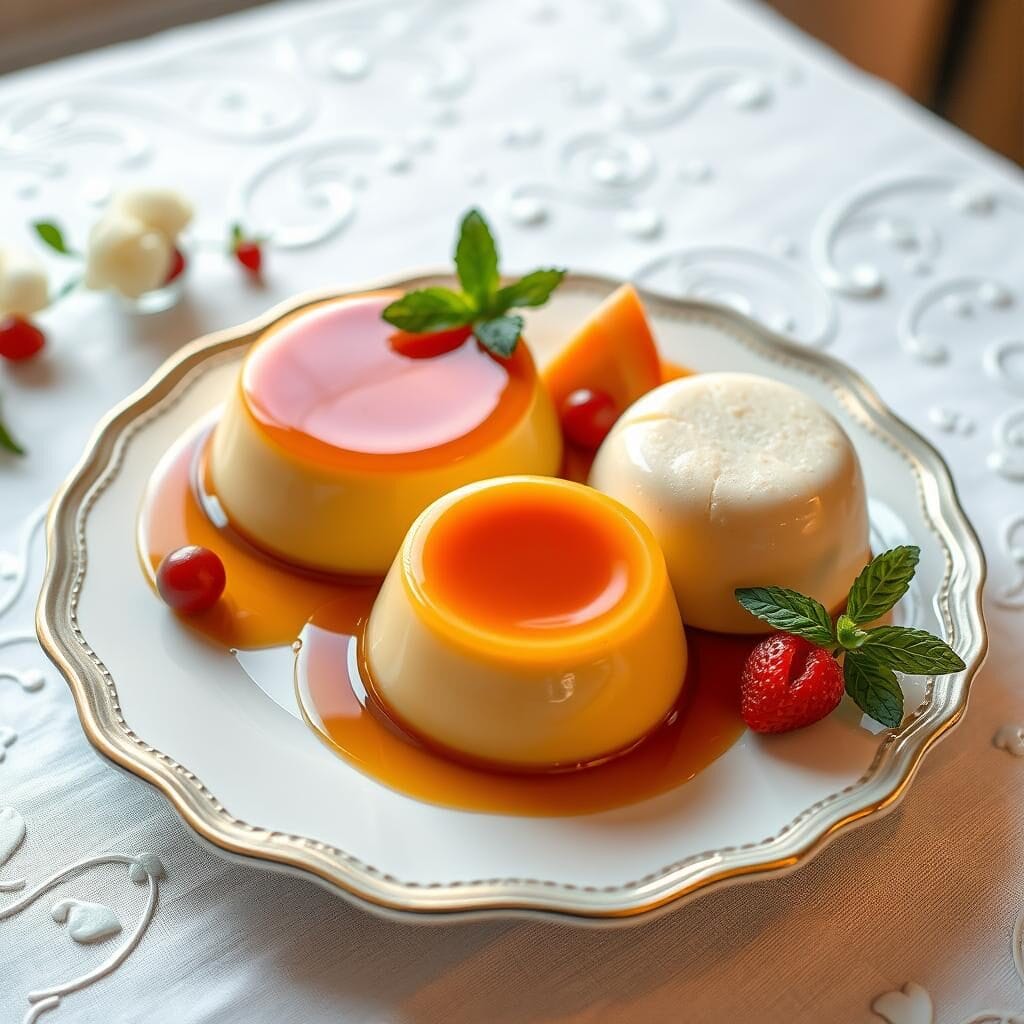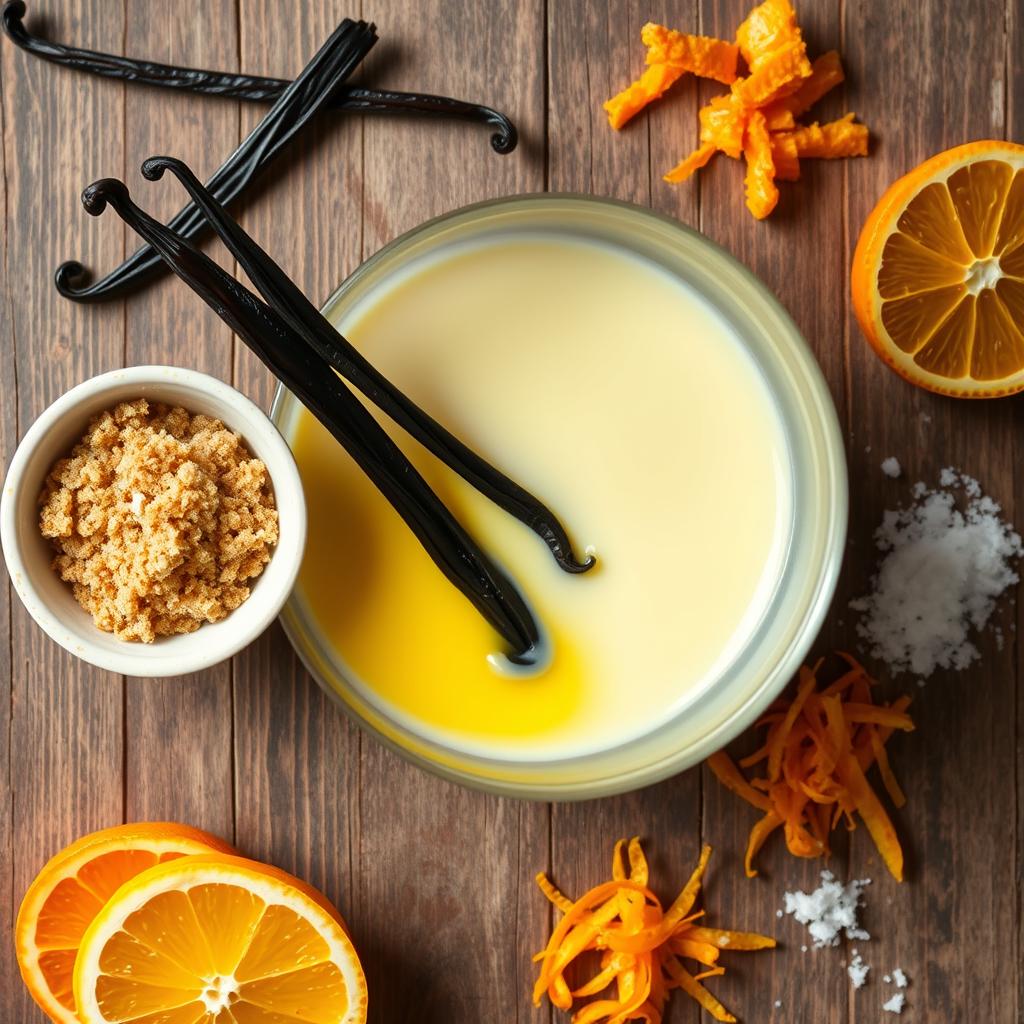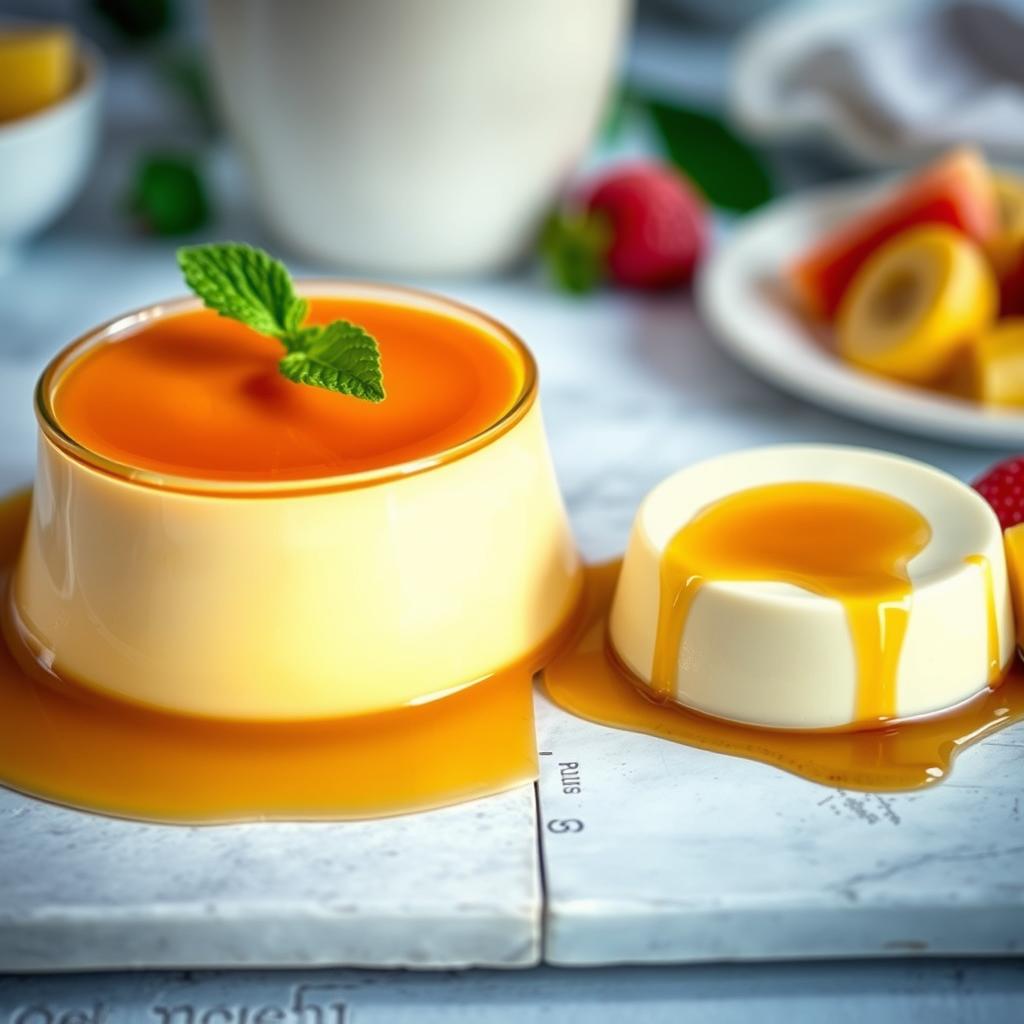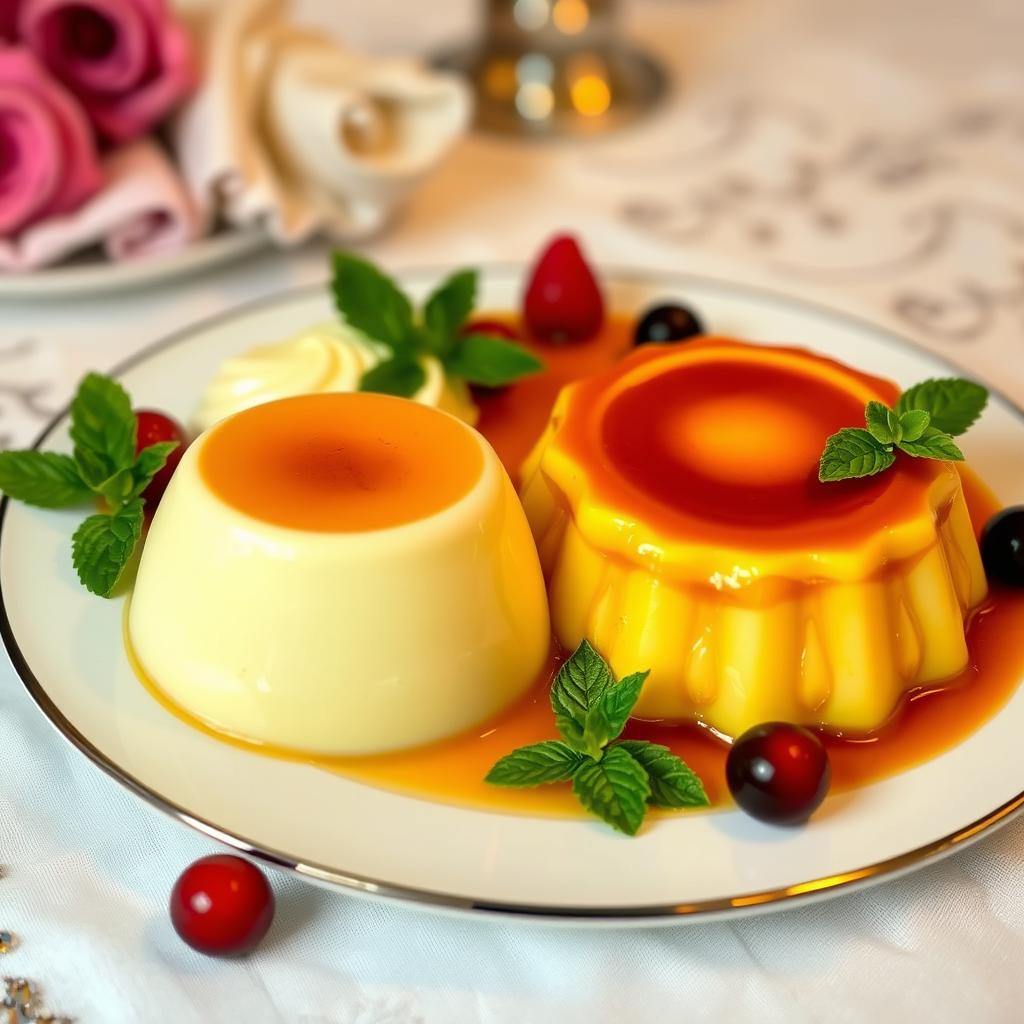In the world of custard desserts, flan and quesillo stand out. They come from Spanish and Latin American cuisines. These egg-based sweets are creamy and indulgent, but they have their own unique qualities.
Flan is a classic dish from Spain. It’s known for its smooth texture and a sweet caramel topping. Quesillo, from Latin America, has a firmer texture. It focuses on the natural sweetness of eggs and milk.

Key Takeaways
- Flan and quesillo are both egg-based custard desserts with origins in Spanish and Latin American cuisines, respectively.
- Flan is known for its smooth, silky texture and caramelized topping, while quesillo has a firmer, denser consistency.
- The flavor profiles of these desserts also differ, with flan emphasizing the caramelized sugar and quesillo highlighting the natural sweetness of the egg and milk ingredients.
- Understanding the distinct characteristics of flan and quesillo can help you appreciate the nuances of these beloved custard treats.
- Exploring the different types of custard desserts can broaden your culinary horizons and delight your taste buds.
Origins and Cultural Significance of Both Desserts
The stories of flan and quesillo are woven into the fabric of Spanish cuisine and Latin American cuisine. These desserts have grown from simple treats to symbols of culture in many places.
Spanish Influence on Flan Development
Flan’s roots go back to ancient Roman custards. The Spanish made it even better during their colonial days. Its creamy texture and caramel top show Spain’s deep love for food.
Latin American Roots of Quesillo
Quesillo, on the other hand, comes from the lively Latin American cuisine. Known as “dulce de leche flan,” it’s loved in Venezuela, Mexico, and Central America. It’s a big part of local celebrations and daily treats.
Cultural Importance in Different Regions
Flan and quesillo have become key parts of their cultures. Flan is a favorite in Spain and its former colonies, appearing at family events and holidays. Quesillo, meanwhile, is a source of pride in Latin American countries. It’s cherished for its taste and ties to local food traditions.
“Flan and quesillo are not just desserts; they are edible representations of the rich cultural heritage and culinary evolution of their respective regions.”
Basic Ingredients Used in Flan and Quesillo
Flan and quesillo share common ingredients. They both use eggs and dairy products to create their creamy textures. Let’s look at what makes these desserts special.
Eggs are at the core of both flan and quesillo. They add structure and a creamy feel. Flan often uses more eggs than quesillo.
Dairy like milk and cream are key. They make the desserts smooth and creamy. Flan uses a mix of milk and cream, while quesillo might add cheese for a savory twist.
Sugar is essential for sweetness. It can be regular sugar or caramelized for the top. Vanilla or other flavors can also enhance the taste.
| Ingredient | Flan | Quesillo |
|---|---|---|
| Eggs | Higher egg-to-milk ratio | Moderate egg-to-milk ratio |
| Milk/Cream | Combination of milk and cream | Milk-based, may incorporate cheese |
| Sugar | Granulated sugar, caramelized sugar topping | Granulated sugar, caramelized sugar topping |
| Flavors | Vanilla extract | Vanilla extract, other aromatic flavors |
Knowing the ingredients of flan and quesillo helps us see their differences. These egg-based sweets and custard desserts are loved worldwide. The mix of ingredients creates their unique tastes and textures.

What is the difference between flan and quesillo?
Flan and quesillo are two classic Latin American desserts. They might look similar at first, but they have different texture, flavor, and looks.
Texture Variations
Flan is smooth and silky. It’s made with eggs, milk, and sugar. Quesillo, however, is firmer and more gelatinous. It has cheese in it.
Flavor Profiles
Flan tastes light and vanilla-tinged. Quesillo has a richer, pronounced cheese flavor. It also has caramel or sweetened condensed milk notes.
Visual Distinctions
Flan has a shiny, golden-brown caramel top and a smooth inside. Quesillo looks more opaque and creamy. It has a smooth, gelatinous feel.
| Characteristic | Flan | Quesillo |
|---|---|---|
| Texture | Smooth, silky | Firm, gelatinous |
| Flavor | Delicate, vanilla-tinged | Rich, pronounced cheese flavor |
| Appearance | Glossy, golden-brown caramel topping, custard-like interior | Opaque, creamy, smooth, gelatinous |

Knowing the differences between flan and quesillo helps us enjoy their unique qualities. These desserts are loved in Latin America for good reasons.
Traditional Preparation Methods for Flan
Making the perfect flan is all about balance. It needs a mix of old techniques to get that creamy texture and sweet caramel. These methods have been passed down for ages.
The caramel topping is the heart of flan. It’s made by heating sugar until it turns amber. Then, it’s poured into the dish, covering the bottom and sides. This creates a golden crown that looks amazing with the custard.
- Preheat your oven to about 350°F (175°C).
- In a big bowl, mix eggs, sweetened condensed milk, and whole milk well.
- Pour the custard into the caramel dish.
- Put the dish in a bigger pan with hot water, like a bain-marie.
- Bake for 45 to 60 minutes, until it’s just set.
- Let it cool, then chill for at least 2 hours before serving.
The traditional way to make flan is baking it. This slow cooking makes the custard perfect and the caramel topping crunchy and sweet.
Flan is loved worldwide for its creamy texture and beautiful look. Learning the traditional ways to make it lets you enjoy this classic dessert at home. It’s a way to celebrate flan’s rich history and taste.
Quesillo Making Techniques and Tips
Making the perfect quesillo is all about the right mix of cheese filling, preparation techniques, and cooking tips. This guide will teach you how to make a silky-smooth custard dessert. It’s a key part of Latin American cuisine.
Key Steps in Preparation
- Begin with a top-notch cheese filling like queso fresco or requesón. It should melt well.
- Warm the milk and sugar gently. Be careful not to burn it.
- Beat the eggs well before adding them to the warm milk. This makes the mixture smooth and creamy.
- Put the cheese filling into ramekins or a baking dish. Bake until it’s set but still a bit wobbly.
Common Mistakes to Avoid
- Don’t overbeat the eggs. It can make the quesillo grainy and curdled.
- Don’t overcook the custard. It should be moist and not dry or rubbery.
- Make sure to temper the eggs right. This prevents the cheese filling from separating.
Equipment Needed
To make the best quesillo, you’ll need some key tools:
- A heavy-bottomed saucepan for heating the milk and sugar gently
- A whisk for mixing the eggs into the custard base well
- Ramekins or a baking dish for shaping and baking the quesillo
- A kitchen thermometer to check the custard’s temperature
With the right preparation techniques and cooking tips, you can make a quesillo that looks great and tastes amazing. Dive into the art of this traditional Latin American dessert. It’s sure to impress your guests.
Caramel Topping Variations and Techniques
Creating the perfect caramel topping for your flan or quesillo is a fun journey. There are many cooking techniques and ingredients to try. They can turn a simple caramel into a fancy dessert topping.
The type of sugar you use is key. White granulated sugar is classic, but brown sugar, maple syrup, or honey add unique flavors. The caramel’s color and texture change with the cooking temperature, from golden to mahogany.
You can make the caramel topping even better by adding spices, citrus zest, or vanilla extract. These dessert variations add warm, complex notes that enhance the caramel’s sweetness.
Learning to make the perfect caramel topping takes time and practice. But with some experimentation and focus, you can create amazing caramel for your flan and quesillo.
Regional Adaptations and Popular Varieties
Latin American desserts like flan and quesillo are loved worldwide. They show the rich culture of the region. From the Caribbean to Mexico and Venezuela, each place has its own twist.
Caribbean Versions
In the Caribbean, flan and quesillo get a tropical twist. They use fresh ingredients like coconut milk and tropical fruits. This makes them sweeter and creamier, like a taste of the Caribbean.
Mexican Interpretations
Mexico’s flan and quesillo are special. They mix local spices like cinnamon and vanilla. This creates a flavor that celebrates Mexico’s culture.
Venezuelan Specialties
Venezuela’s flan and quesillo are unique. They use condensed milk for a richer taste. Local ingredients like arequipe add a special touch.
Flan and quesillo show how Latin America values its food traditions. Whether you try the Caribbean, Mexico, or Venezuela, you’ll see the beauty of Latin American desserts.
Serving Suggestions and Pairings
Flan and quesillo can be enjoyed in many ways, making your meal special. These desserts go well with different flavors and drinks. Try adding fresh berries, caramel sauce, or toasted nuts for a nice touch.
For a classic choice, pair flan or quesillo with a strong coffee or a cool Spanish wine. The creamy desserts match well with the bold flavors of the drinks. You can also try them with vanilla ice cream or whipped cream for a fun mix of cold and warm.
Flan and quesillo are perfect for any occasion. They add a special touch to dinner parties, casual get-togethers, or the end of a meal. They offer endless ways to impress your guests and make your dining experience unforgettable.

